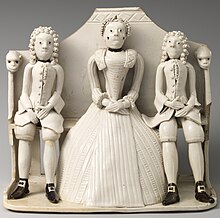
The pew group is a rare type of pottery Staffordshire figure, apparently made only in the 1740s. Typically it has two or three "rigidly posed" figures sitting on a high-backed bench, often with a woman in the centre; great attention is paid to details of hair and clothing. The setting is not church, as the usual name suggests, but a comfortable home or inn, where high-backed settles (protecting from draughts) were a common piece of furniture. Details are picked out in dark brown or black glaze, and dogs and musical instruments may be depicted,[1] or the gentlemen may be taking snuff.[2]
The two most elaborate group subjects in Staffordshire figures were the "arbour group", with two lovers seated in front of a bocage of foliage, and the pew group. The arbour group is a simplification of porcelain groups, whereas the pew group is more original to Staffordshire. Both types are "flatbacks", plain at the rear, as they were designed to be placed against a wall.[3] The figures in arbour groups were already mostly moulded, but the pew groups were shaped and constructed individually, from rolled and moulded pieces of clays, with much use of "slabs" rolled flat.[4][5] Despite the sculptural quality given by the contrast of thin sheets and round forms, this technique was not used for later figures.[6]

It seems likely that they were made as individual commissions by potteries mostly making more routine wares, although almost none are inscribed with names, either of makers or patrons (see below for exception). It is possible the figures were intended as portraits of individuals. Their dating relies as much as anything on the style of the costumes, which are at the least genteel.[7]
Pew groups are rare, and now extremely expensive. A pew group of c. 1745 sold for $168,000 at a Christie's auction in 2006,[8] and in 1986 Sotheby's sold one for $179,520.[9] There are also modern forgeries and imitations; some imitators have acquired their own collectors.[10][11] An even more rare group, intermediate with the arbours, but sharing the pew group technique, was Adam and Eve standing with a very small tree (and snake) between them, and a bench rather oddly placed behind them.[12]
- ^ Poole, 56–57 (online); Wood, 22; Hughes, 181–183, 182 quoted
- ^ Christie's; V&A, "The man on the left wears a black tricorne hat and is taking snuff from his box. The man on the right in a black cap raises his left hand and takes snuff".
- ^ Wood, 21–23
- ^ Hughes, 181–182; Poole, 56–57
- ^ "Pew Group", Fitzwilliam Museum
- ^ V&A
- ^ Poole, 56–57; Note on British Museum example.
- ^ Christie's
- ^ "Passionate Collectors set new Auction Highs", by Rita Reif, 22 January 1987, New York Times
- ^ Wood, 22; "Late 20th-century" imitation, sold as such; another.
- ^ Another Glaisher Fitzwillam example, "circa 1900 — before 1925; probably 20th century fake"
- ^ Wood, 22; Fitzwillam example; Another Glaisher Fitzwillam example, "circa 1900 — before 1925; probably 20th century fake"
© MMXXIII Rich X Search. We shall prevail. All rights reserved. Rich X Search
